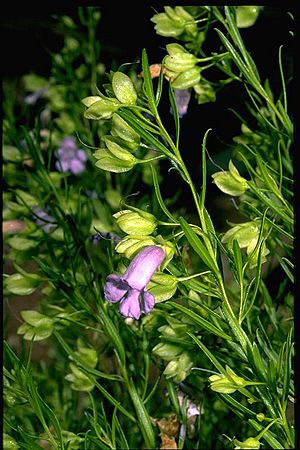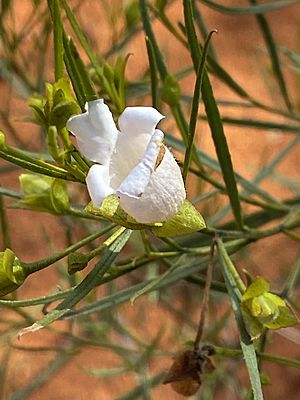Eremophila gibsonii facts for kids
Quick facts for kids Eremophila gibsonii |
|
|---|---|
 |
|
| Scientific classification | |
| Genus: |
Eremophila (plant)
|
| Species: |
gibsonii
|
| Synonyms | |
|
|
The Eremophila gibsonii is a type of flowering plant. It belongs to the figwort family, called Scrophulariaceae. This plant is special because it is found only in Australia. It is a sticky, smooth shrub with narrow leaves. Its flowers can be white or a light purple (lilac) color. You can find this plant in Western Australia, South Australia, and the Northern Territory.
Contents
What Does Eremophila gibsonii Look Like?
Eremophila gibsonii is a shrub that grows upright and has a rounded shape. It usually reaches a height of about 1 to 2.5 meters (3 to 8 feet). The plant is smooth and shiny because it has a sticky substance called resin on it.
Its Leaves
The leaves of this plant are spread out along the branches. They are long and thin, usually about 22 to 43 millimeters (0.9 to 1.7 inches) long. Each leaf is about 0.8 to 2 millimeters (0.03 to 0.08 inches) wide. They have a small hook at the end and feel rough. Often, the edges of the leaves have pointed teeth.
Its Flowers
The flowers grow either alone or in small groups of up to three. They appear where the leaves meet the stem. Each flower sits on a stalk that is about 5 to 15 millimeters (0.2 to 0.6 inches) long.
There are five green, shiny, and sticky parts called sepals at the base of the flower. These sepals are different sizes and shapes. They grow bigger after the flower blooms. The petals of the flower are about 19 to 29 millimeters (0.7 to 1.1 inches) long. They are joined together at the bottom to form a tube shape.
The petal tube is white or a light lilac color. The outside of the tube is covered with tiny hairs that produce a sticky substance. Inside the tube, there are many long, soft hairs. The flower has four stamens, which are the parts that produce pollen. These stamens are completely hidden inside the petal tube.
When It Flowers and Fruits
Eremophila gibsonii usually flowers from August to October. After flowering, the plant produces fruits. These fruits are woody and have a hairy, papery covering. They are oval-shaped and about 5 to 6.5 millimeters (0.2 to 0.26 inches) long.
How Eremophila gibsonii Got Its Name
This plant was first officially described in 1874 by a scientist named Ferdinand von Mueller. He published his description in a book called Fragmenta phytographiae Australiae.
The plant's specific name, gibsonii, was given to honor Alfred Gibson. Alfred Gibson died in 1874 during an exploration trip led by Ernest Giles. The famous Gibson Desert is also named after him.
Where Eremophila gibsonii Grows
You can find Eremophila gibsonii in several parts of Australia.
In Western Australia
In Western Australia, it grows in the western areas. These include regions like the Central Ranges, the Great Victoria Desert, and the Murchison area.
In South Australia and Northern Territory
In South Australia, it is found in the North-Western, Nullarbor, and Gairdner-Torrens plant regions. It also grows in the very southwestern corner of the Northern Territory. This shrub is quite common on sand dunes in central Australia.
Is Eremophila gibsonii Endangered?
The Western Australian Government Department of Parks and Wildlife has looked at Eremophila gibsonii. They have classified it as "not threatened." This means the plant is not currently at risk of disappearing.
Growing Eremophila gibsonii in Gardens
This plant is known for its delicate, wispy leaves and pretty white to pale blue flowers.
How to Grow It
You can grow new plants from cuttings. If you use cuttings, the plant needs to grow in deep sand. However, if you use a plant that has been grafted (meaning it has parts from two different plants joined together), it can grow well in many different types of soil. It needs a lot of sunshine. Once the plant is fully grown, it can handle dry periods (drought) and cold temperatures (frost).


